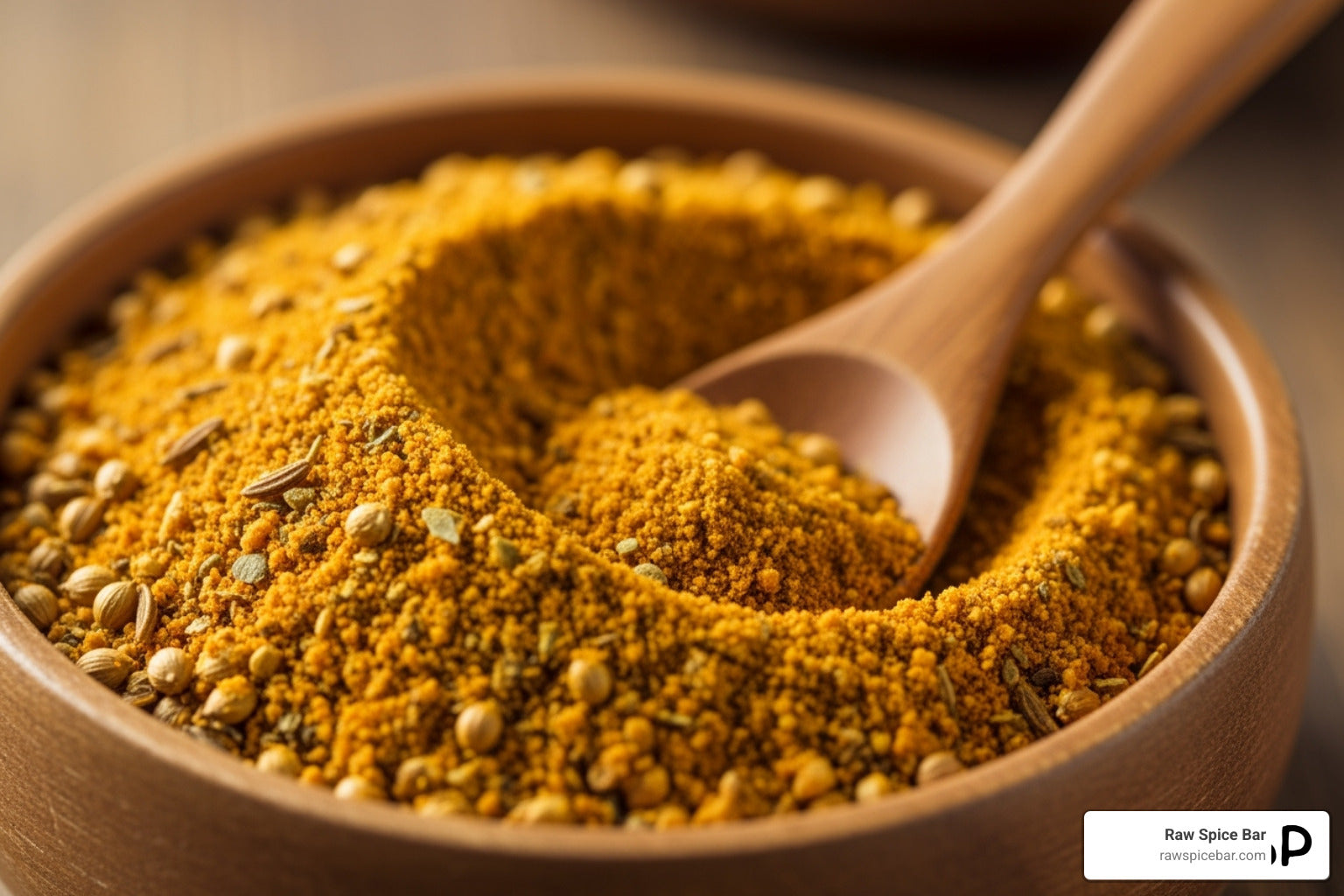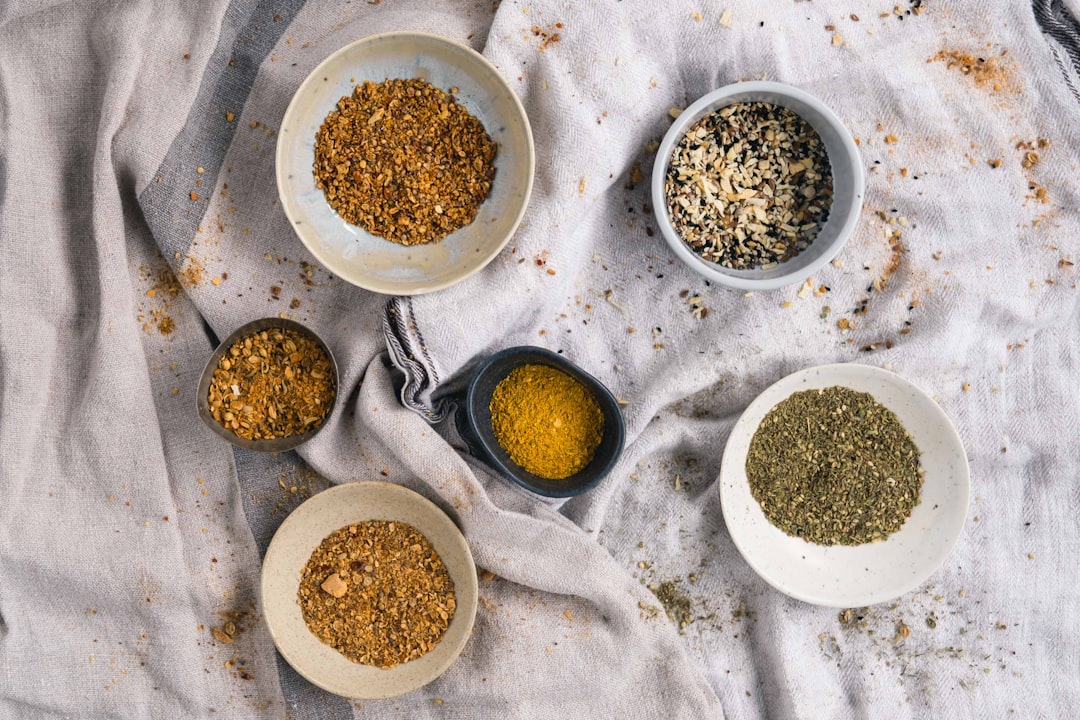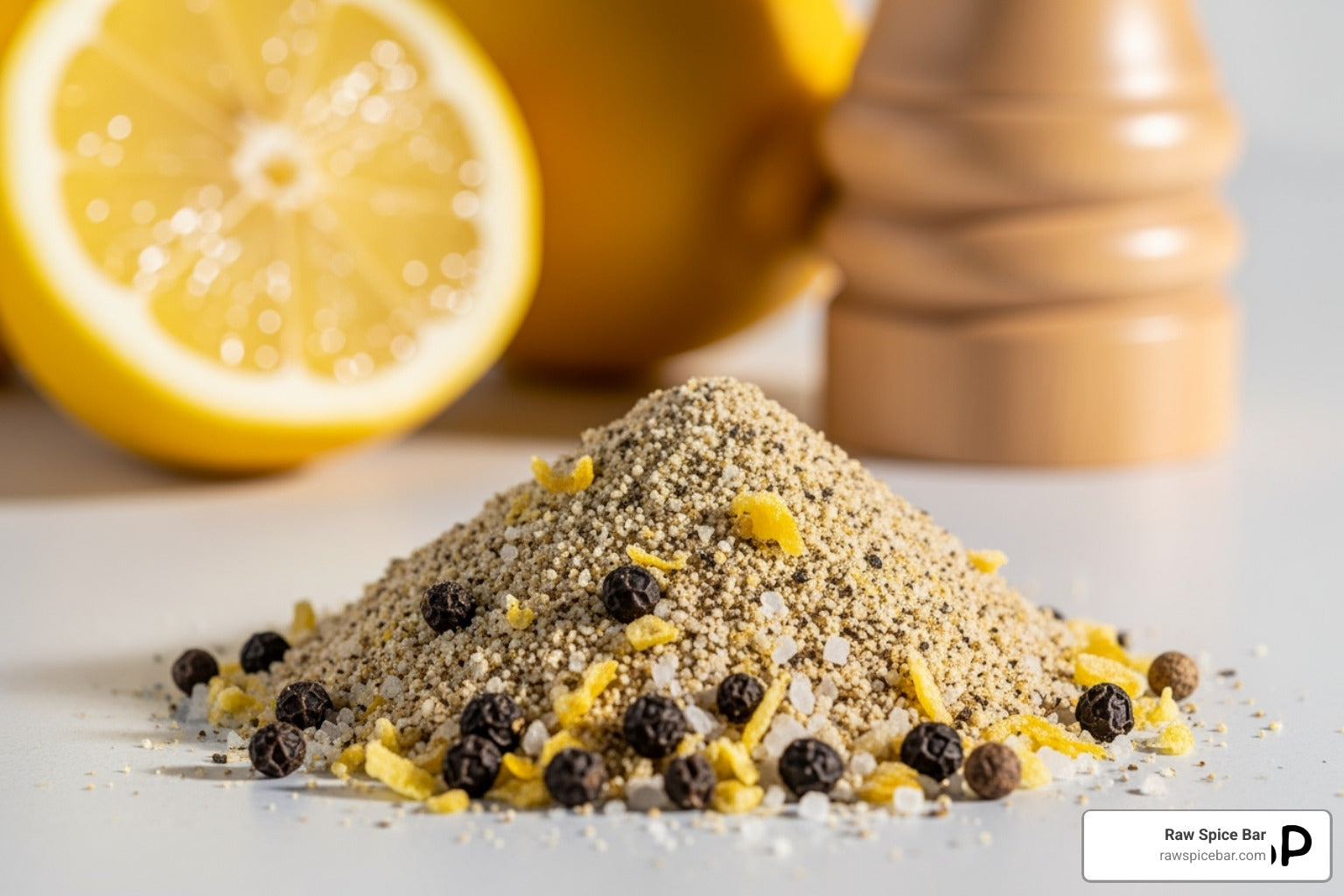Exploring new cuisines can be as simple as opening your spice cabinet.
Raw Spice Bar offers a subscription service that brings globally inspired spices to your home. This allows you to explore the rich flavors of distant places without leaving your kitchen.
Each month, you receive hand-blended spices and a recipe card to guide you in creating authentic dishes worldwide.
By embracing these vibrant spice blends, you can transform everyday meals into flavorful experiences. Whether it's the heat of a Cajun blend or the aromatic notes of a curry mix, each spice unlocks a part of its cultural heritage. Our team ensures these spices are fresh and salt-free, making them healthy choices for enhancing your dishes.
With these global spices, cooking becomes an adventure. Imagine tasting the zest of Mexico or the subtle warmth of Indian spices with every dish you prepare. Our combinations bring new flavors to your meals and introduce you to a world of culinary traditions right from your kitchen.
In this blog, you will learn:
-
How spices can transform your meals and connect you to different cultures
-
The importance of fresh, salt-free spice blends for both flavor and health
-
How RawSpiceBar’s subscription service can help you explore new cuisines with ease
Let’s find out!
The Importance of Spices in World Cuisines
Spices play a crucial role in transforming ordinary meals into extraordinary culinary experiences. They have shaped the flavors of dishes worldwide and significantly influenced trade and culture throughout history. You can explore these rich flavors with carefully crafted spice blends.
Historical Significance of Spices
Historically, spices like pepper, cinnamon, and cloves have been highly valued.
They were crucial in trade routes, such as the Silk Road, which connected different regions of the world and facilitated cultural exchanges. These routes allowed spices to reach not only Europe from Asia but also varied regions, spreading unique flavors and culinary traditions.
Spices were often considered luxury items. They held a place of prestige on the tables of the wealthy and powerful—the demand for exotic spices led to exploration and even wars, illustrating their immense value.
Understanding this historical context provides deeper insight into the culinary traditions that continue to shape cuisines today.
Cultural Impact Through Flavor Profiles
Spices enrich dishes by adding distinct flavors, colors, and aromas, making each cuisine unique.
Indian cuisine, for example, uses an array of spices like turmeric and garam masala to create its signature warmth. Similarly, Moroccan dishes often feature cumin and saffron, offering bold and complex tastes.
Our spices are celebrated for their ability to inspire creativity in cooking. We produce spice blends that allow you to experience flavors from around the globe, making cooking easy and enjoyable.
Our global spice subscription brings new, salt-free blends with recipe cards to your doorstep, enhancing your culinary adventures with fresh, authentic tastes.
Discovering New Cuisines
Engaging with new cuisines can be exciting, as it gives you the chance to explore diverse flavors and ingredients from around the world. Using globally inspired spices is a crucial aspect of this culinary journey, allowing for a deeper appreciation of different cultures.
Exploring Regional Cuisines
Exploring regional cuisines involves understanding the traditional dishes and ingredients specific to different areas worldwide. Every region has unique culinary traits, from the spicy foods of Thailand to the rich, creamy curries of India.
These dishes often rely on distinct spice combinations to bring out particular flavors. For example, Italian cuisine is known for using oregano, basil, and rosemary, while Mexican dishes often include cumin and chili powder.
The Role of Spices in New Culinary Experiences
Spices are the backbone of many dishes, transforming simple ingredients into flavorful meals. Our focus is on creating spice blends that are both healthy and salt-free, ensuring that your dishes are flavorful and wholesome.
These blends can elevate any recipe, adding complexity and richness. Whether it's the smoky paprika of Spanish cuisine or the tangy sumac from the Middle East, each spice offers a unique experience.
Our monthly spice subscriptions ensure you receive these global tastes directly to your home, making it easy to try new flavors consistently. This subscription makes experimenting with international recipes straightforward and accessible for everyone.
Globally Inspired Spices
Discovering new cuisines is a journey of flavors. You can explore unique tastes and enhance your cooking experience with globally inspired spices. There's much to learn and savor, from distinctive continent-specific spices to innovative blends.
Signature Spices by Continent
Each continent offers its own set of signature spices that capture the essence of its cuisine.
In Asia, bold flavors like Sichuan peppercorns and star anise are essential in many regional dishes. Meanwhile, European smoky paprika is crucial in Spanish and Hungarian cooking.
Africa’s culinary scene often highlights berbere and harissa, which are known for their intense warmth and complexity. In the Americas, chili peppers create a range of heat levels, while Mexican vanilla adds sweetness.
Understanding these regional spices can bring authenticity to your kitchen and deepen your appreciation for global culinary traditions.
Fusion Flavors and Spice Blends
Creating fusion dishes with spice blends allows you to experiment with diverse flavors.
We offer a global spice subscription that introduces you to exciting blends, like a Seoul Fire BBQ for fiery Korean-inspired meals or Ras el Hanout for Moroccan dishes. Our blends come with recipe cards to guide your cooking with new flavors.
These blends combine spices from various continents, creating unique tastes that challenge conventional cooking. By incorporating these blends, you can craft meals that are not only tasty but also inventive. Whether you are an adventurous cook or want to try something new, our spices can transform your culinary routine.
Cooking Techniques for Authentic Flavors
Using the right techniques can make a huge difference in unlocking the full potential of your spices. Paying attention to how spices are prepared and stored ensures you capture their true flavors, creating dishes that connect you with cuisines worldwide.
Roasting and Grinding Spices
Roasting spices enhances their flavors by releasing essential oils, making your dishes more aromatic. You can roast spices in a dry pan on medium heat for a few minutes until they smell fragrant. Be careful not to burn them, as this can lead to a bitter taste.
After roasting, grinding the spices helps release their full potential. Use a mortar and pestle or a spice grinder to achieve the desired texture. Freshly ground spices have a more robust taste than pre-ground ones from the store.
Proper Spice Storage for Freshness
To maintain the potency of your spices, proper storage is crucial.
Spices should be kept in airtight containers to protect them from moisture and air exposure. They should also be stored in a cool, dark place, away from direct sunlight and heat, which can degrade their quality.
Check your spices regularly for their aroma and color. If they start losing these, it might be time to replace them. By following this, you'll maximize the taste and longevity of your spice collection.
Learning from Global Cuisine Experts
Culinary mastery often comes from understanding the insights of professional chefs and embracing traditional cooking methods. These elements can enrich your cooking experience and help you create vibrant, flavorful dishes.
Professional Chefs' Insights
Professional chefs bring years of experience and a deep understanding of flavors to their craft.
Many suggest starting by focusing on high-quality ingredients, including spices, to enhance the taste profile of meals. For instance, using high-quality spice blends can make a significant difference. They refine classic recipes by introducing new flavor dimensions and ensuring each bite is a delightful experience.
Chefs also emphasize the importance of continuous learning. They often draw inspiration from cuisines worldwide, adapting and creating dishes that reflect a blend of cultures. This approach broadens your culinary repertoire and introduces exciting and unique flavors to your meals.
Understanding the chef’s techniques and choices can serve as a valuable guide for cooking at home.
Traditional Cooking Methods
Traditional cooking methods have been passed down through generations.
They are crucial for authentic flavor development. Techniques like slow cooking, roasting, and marinating help enhance the depth of flavors in dishes. Traditional methods can produce rich and satisfying meals, perfect for exploring new spices and global cuisines.
You can integrate these methods by starting with basics like marinating meats with spice blends. This allows the flavors to penetrate and infuse thoroughly. Slow cooking, another method, helps tenderize meats and draw out the natural flavors, especially when you incorporate seasonal spice blends from around the world.
Understanding these techniques allows you to create delicious and authentic meals.
Spice Sourcing and Selection
Choosing the right spices is crucial when seeking to create authentic dishes. This involves selecting ethically sourced spices and identifying high-quality options. Using fresh, vibrant spices can significantly elevate your culinary creations.
Choosing Ethically Sourced Spices
When selecting spices, it's essential to consider the origin and ethical practices of the suppliers.
You want to source spices responsibly, promote fair trade, and support local communities. Ensuring ethical sourcing means the farmers receive fair wages for their hard work.
Furthermore, it helps preserve the environment by encouraging sustainable farming practices. By subscribing to our service, you can enjoy a variety of ethically sourced spices that make your dishes flavorful while supporting responsible farming.
Identifying Quality in Spices
Quality spices have a distinct aroma, vibrant color, and a potent flavor. These characteristics indicate freshness and potency. Avoid spices that appear faded or have a dull smell, as these might have lost their flavor.
You can often identify quality by checking if a spice clumps together; this shows the presence of essential oils. We ensure our blends are fresh, providing spices that enhance every meal.
Incorporating Spices into Everyday Meals
Spices can transform regular dishes into delicious meals. By understanding how to balance flavors and using simple techniques, you can easily enhance your daily cooking routine by introducing a fresh twist through globally inspired spices.
Balancing Flavors for Daily Cooking
Balancing spices in your meals involves mixing different flavors to create harmony in each dish.
Begin by identifying the key notes of the spices you have. Some are mild, like cumin, while others, like cayenne, offer more heat. Sweet spices like cinnamon work well in desserts but can also add depth to savory dishes when balanced with other spices.
To balance flavors, pair spicy elements with something cooling or sweet. For instance, adding yogurt or a squeeze of citrus can mellow the heat if a dish is too spicy. When using spice blends, consider their complexity.
Each blend is crafted to bring notes from its region, like smoky paprika from Spain or fragrant Herbes de Provence. These balances make your dishes stand out without being overpowering.
Simple Spice Incorporation Techniques
Incorporating spices into your meals doesn't have to be complicated.
Start small by adding a pinch of spice to your usual recipes. This could mean sprinkling a bit of turmeric on roasted vegetables or adding a dash of sumac to salad dressings.
Another technique is making your own spice-infused oils and vinegars. Add whole spices like cloves or star anise to olive oil or vinegar, then let it sit for a week to absorb flavors. The result is a flavorful addition that can be drizzled over dishes.
These spice blends come with recipe cards that offer creative ways to incorporate complex flavors into seasonal cooking, allowing you to experiment with global cuisines right from your kitchen.
Creating a Globally Inspired Pantry
Creating a globally inspired pantry involves adding diverse spices that capture flavors worldwide. This involves choosing and organizing the right spices efficiently to make meal preparation simple and fun.
Must-Have Spices for Home Cooks
To start, consider incorporating versatile spices into your pantry.
-
Paprika adds a smoky and sweet touch to many dishes.
-
Cumin is essential for Middle Eastern and Mexican recipes, offering a warm, earthy flavor.
-
Coriander, another staple, is common in Indian and Asian cuisines for its citrusy taste.
-
Turmeric is known for its vibrant color and health benefits and is used in curries and rice dishes.
-
Sumac provides a tangy zest to Middle Eastern meals.
-
Cinnamon is a wonderful spice for sweet and savory recipes, adaptable in various cuisines from Latin America to Asia.
-
Including herbs like oregano and basil for Italian dishes is also beneficial.
Organizing Spices for Easy Access
Proper organization of your spices is crucial.
A spice rack or drawer can keep jars within easy reach.
Labeling spices helps you find what you need quickly. Group spices by cuisine or use, such as baking or grilling, to streamline your cooking process.
Clear containers allow you to see when supplies run low, encouraging timely replenishment. To maintain freshness, keep spices in a cool, dark place.
Organizing and regularly updating your spices guarantees your pantry remains efficient and inspiring as you explore new flavors.
Health Benefits of Common Spices
Using spices in your meals isn't just about flavor. Many spices also offer health benefits, from boosting immunity to aiding digestion. Adding these spices to your diet can improve your well-being while making your dishes more exciting.
Spices with Medicinal Properties
Certain spices have been celebrated for their health-enhancing properties.
-
For instance, turmeric contains curcumin, which may help reduce inflammation.
-
Similarly, black pepper enhances the absorption of curcumin, boosting its effectiveness.
-
Ginger is another powerful spice that can ease nausea and improve digestion.
-
Vanilla may lift your mood with its pleasing aroma.
These are just a few examples, but incorporating a variety of spices can benefit your health in multiple ways.
Incorporating Healthy Spices into Diets
With some planning, you can easily add healthy spices to your daily meals. For example, sprinkle cinnamon over your breakfast oatmeal or yogurt for an antioxidant boost.
Add turmeric and black pepper to soups and stews to enhance their flavor and health benefits. You can enjoy the convenience of a global subscription that delivers vibrant, salt-free spice blends to your home.
Experimenting with different spices can make cooking enjoyable and flavorful while supporting your health.
Cooking Workshops and Travel
Exploring cooking workshops and travel can elevate your culinary skills and expand your palette. Discover hands-on cooking classes that immerse you in new techniques and flavors, and travel to culinary hotspots rich in food traditions.
Interactive Cooking Classes
Interactive cooking classes offer you the chance to learn by doing. In these classes, you engage with expert chefs who guide you through recipes step by step.
You can expect to master different techniques, from chopping and grilling to blending spices. Many of these classes also take the opportunity to introduce you to international cuisines, challenging you to try new ingredients and recipes.
Using our curated spices, you can transform each dish, ensuring your creations are as vibrant and authentic as intended. These classes teach you not only how to cook but also how to appreciate the diversity of global flavors.
Culinary Travel Destinations
Traveling to culinary destinations allows you to immerse yourself in the origin of classic dishes.
Countries like Italy, Mexico, and Thailand offer unique cooking styles that reflect their local culture and history. You can join food tours, take short-term cooking courses, or attend food festivals to get a true taste of the region.
When you're back home, keep the flavors alive with our spice subscription. Our carefully selected tastes worldwide help you recreate those unforgettable dishes.
Whether you're seasoned in the kitchen or just starting out, cooking and traveling open up a world of delicious possibilities.
Frequently Asked Questions
Spices can completely transform your cooking, and if you’ve never used globally inspired blends, you’re in for a treat! But, you might have a few questions before you start experimenting with new flavors. We’ve got you covered! Here are some common questions about spices and how you can use them to elevate your meals.
What spices are essential for creating authentic international dishes?
Spices like cumin, coriander, and paprika are often essential to creating authentic international dishes. These spices help bring out the unique flavors that define different regional cuisines.
Which spices are most commonly used in Middle Eastern cuisine?
Middle Eastern cuisine often features spices like sumac, za'atar, and saffron. These give dishes distinctive aromatic and flavorful flavors.
Can you list five spices that are predominant in South Asian cooking?
South Asian cooking typically uses turmeric, cumin, cardamom, coriander, and mustard seeds. These spices are key in creating rich and aromatic dishes in this region.
What are the key spices to use for an authentic Latin American dish?
Smoky paprika, chili powder, and cumin are common spices in authentic Latin American dishes. These spices help bring a vibrant and warming flavor to many regional recipes.
Which spices are critical for achieving the flavors of traditional African cuisine?
Spices like berbere, allspice, and nutmeg are important in traditional African cuisine. These spices add depth and complexity to dishes, making them uniquely delicious.
What herbs and spices are fundamental to European culinary traditions?
European cooking often uses herbs and spices such as basil, rosemary, thyme, and garlic. These add delicate and savory nuances to dishes, enhancing their flavors with freshness.




